Optimal Solar Pool Collector Install Angles
Article posted by Gregory Grochola (physicist) on 29th Jan 2019
Sometimes we get asked for the best roof facing compass direction and pitch (tilt) to install pool heating collectors on to get the longest swimming season, or how much of a penalty there is installing on south-facing roofs. These days with PV solar systems taking up so much prime North facing roof real estate, we thought it might be a good idea to use our new simulator to work out optimal install angles for various roofs. Some of these charts are available in the AS 3634-1989 Pool Heating Standard, however firstly, they are in need of updating in our opinion but secondly, they are not freely available to the public, which is a shame we thought. So we're releasing this extended analysis. For a full validation of the simulator used to calculate these charts see here. For the actual simulator see here.
Generally, East facing collectors run at lower efficiencies as compared to West mounted collectors, this is because West mounted collectors get the benefit of warmer afternoon roof air and latent heat from dark colour roofs which can get up to 70ºC in the roof space, however, this is offset somewhat due to stronger wind speeds in the afternoon, which lowers unglazed collector efficiencies. Furthermore, for most states, due to climate conditions, there is generally more sunshine falling on an East facing roof than on a West facing roof. The charts below take all of these factors into consideration. (To compare your roof, see Google maps (North=Up) to approximate your roofs compass facing direction. Note: magnetic compass North is not equal to True geographic North, always use a map. Note: -10º pitch is a South facing install.)
Optimal Solar Pool Collector Install Angles for Average Pools without a Blanket
For these first sets of charts, we used an average pool: average wind exposure, with an average season extension, 100% traditional 8 tube solar collector coverage mounted on a cooler carport roof (to exclude any latent dark roof heat effects for now), no solar blanket, limited to 29ºC (30ºC in Brisbane, 31ºC in Darwin).
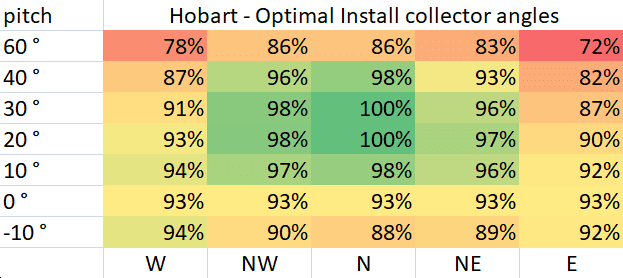
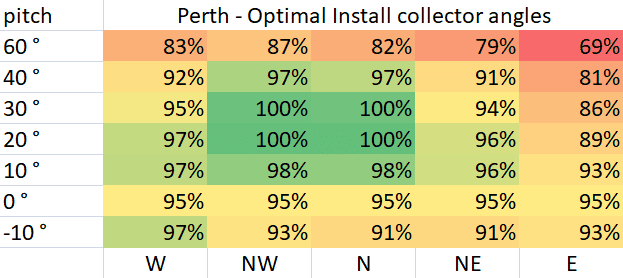
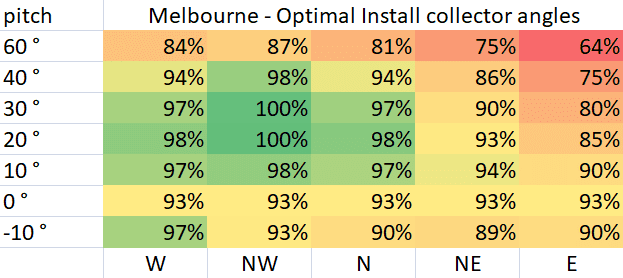
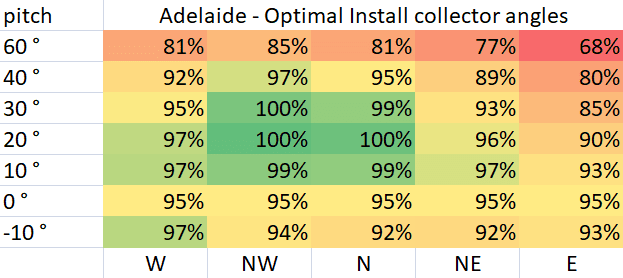
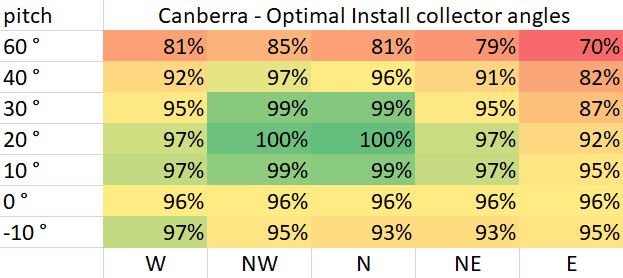
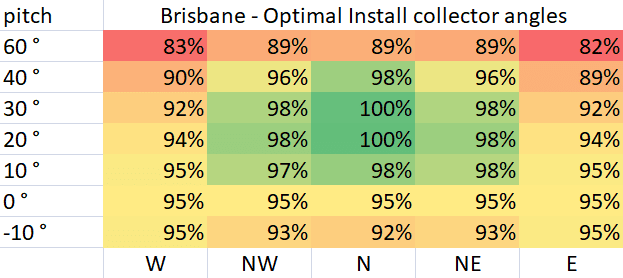
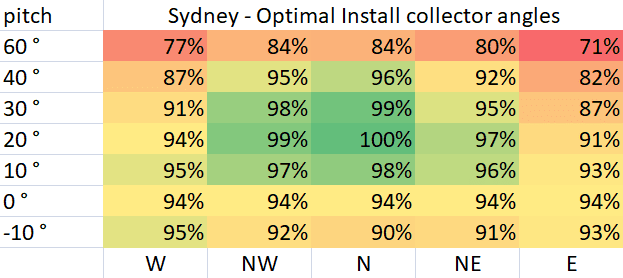
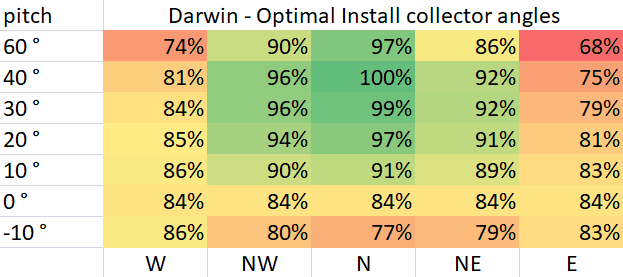
For pools without pool blankets, the optimal install angles range from NW to N (with Melbourne having the greatest shift toward NW), with optimal tilts ranging from about 20º to 25º. Darwin is a special case with a high optimal tilt, as the bulk of the pool heating season happens in the winter. But let's see now how the optimal angles change for pools with a solar blanket and a larger 120% solar collector coverage.
Effects of a Pool Blanket
The next set of charts show optimal install angles for pools with the maximum possible season extension. Such pools use solar blankets with 120% solar coverage (60% coverage for Darwin). The pools were temperature limited to a warm 31ºC (32ºC in Perth, Sydney and Brisbane, 33ºC in Darwin). As can be seen, the use of a solar blanket has a large effect on the optimal install angles for some states, moving the sweet spot to a higher pitch. The most affected states are those where the use of a solar blanket by itself is good enough to provide the bulk of the heating in summer (Canberra, Perth, Adelaide and Brisbane), hence shifting the bulk of the solar collection to the shoulder months where the sun is lower in the sky.
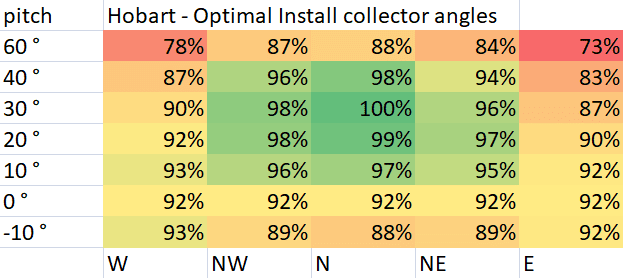
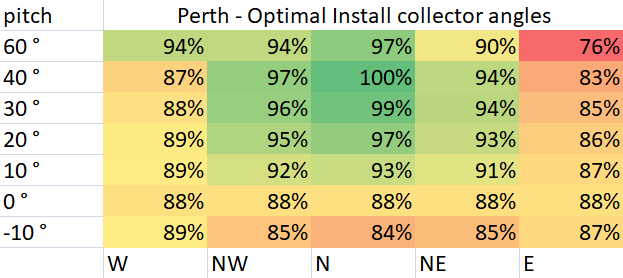
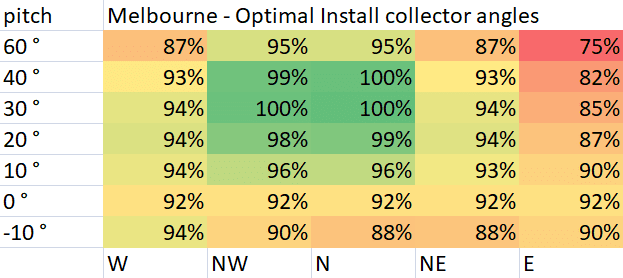
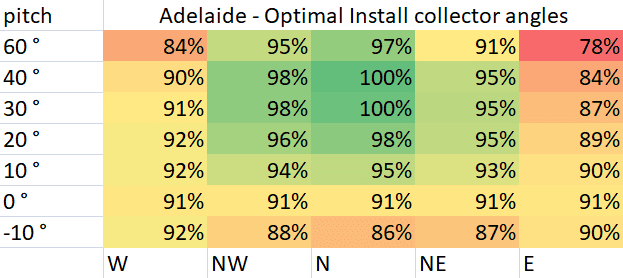
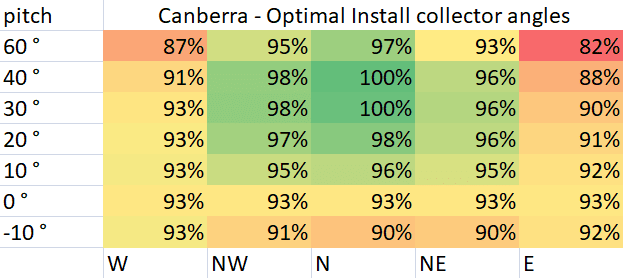
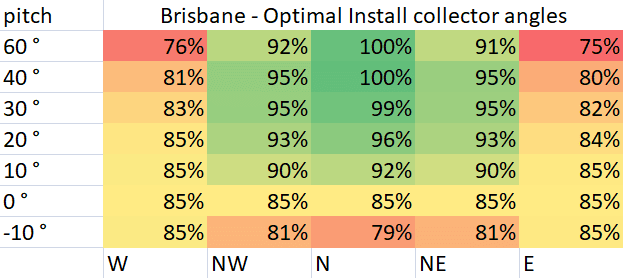
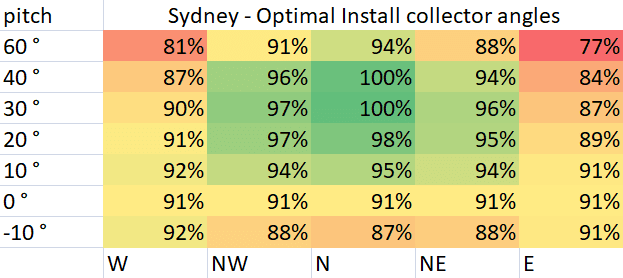
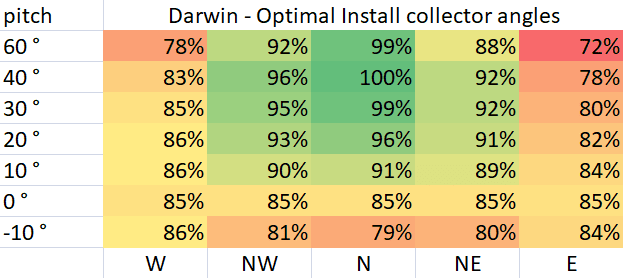
Optimal tilts shifted as follows: Hobart 25º to 28º, Melbourne 25º to 30º, Canberra 20º to 38º, Sydney 21º to 32º, Perth 23º to 39º, Adelaide 20º to 39º, Brisbane 25º to 50º, Darwin 39º to 40º.
The greatest shift happened in Brisbane, which had its optimal tilt moved up by a whopping 25º to about a 50º tilt. This is because for Brisbane the solar blanket provided the bulk of the heating in summer, hence we didn't need to run the solar much in summer, only in the cooler Autumn and Spring months when the sun is lower in the sky. The smallest shift happened in Darwin where the bulk of the solar collection season didn't really change with the use of a solar blanket, it was still June/July.
It should be noted for these second calculations, that we prioritized the use of a blanket over the use of solar heating in summer. If on the other hand, we prioritized the use of solar to bring the pool up to temperature in summer over the pool blanket, for example, the pool owner might want to do away with the use of a blanket in summer due to the hassle of taking it on and off; then the results would be similar to the first set of charts with only a small shift to higher tilts, as in this case, we are not shifting the bulk of the solar collecting season.
Effects from a Darker Hotter Roof
Now we need to mention the important effects of dark hot roofs. The above charts were created using a cooler carport roof, darker roofs with roof cavities will get warmer and retain more heat in the afternoon. Taking this into consideration, we found the optimal points for the above charts will shift toward West by:
- 10º for Zincalume metal roofs
- 15º for light tile type roofs
- 22.5º for dark roofs (tile or metal)
Generally, the darker the roof and the more heat the roof stores in the roof cavity the greater the shift. One caveat: roof space cavities with active cooling systems may only get half the above-mentioned shifts. Hence if you're in Melbourne and have a dark tile roof, you're optimal direction is going to be 45º (from the first average pool chart) + 22.5º (from the dark roof shift) = 67.5º or WNW.
Summary
So to summarize, there were small shifts toward a West install from differences in morning/afternoon weather/solar conditions, mainly for Melbourne, less so for Canberra, Perth, Sydney, Darwin and Adelaide, and none at all for Brisbane and Hobart. There is an additional shift toward West for dark roofs with latent heat storage. In terms of optimal tilt, this is generally going to be facing the suns angle during the solar heating season you're targeting. So for example if you're in Tasmania and you have a cooler pool; perhaps you have some wind exposure and you just want a warmer summer swimming season and don't care for a season extension as much, then you are really going to do the vast majority of solar collecting in the summer, when the sun is normal to a tilt angle of 43º (Lat) - 22.5º =20.5º at 12 noon. If you're in Brisbane and you want near year-round heating, so you install a large 120% coverage collector and use a solar blanket whenever you can, then you really need to optimize for winter collection when the sun is normal to a tilt of 27.5º (Lat) + 22.5º =50º.
If you enjoyed this article please share, it'll help us get the word out about solar and renewables :)

